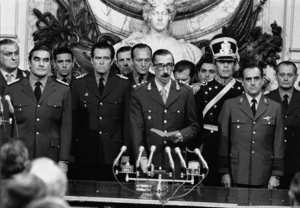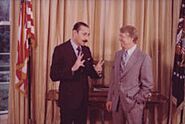Jorge Rafael Videla facts for kids
Quick facts for kids
Jorge Rafael Videla
|
|
|---|---|
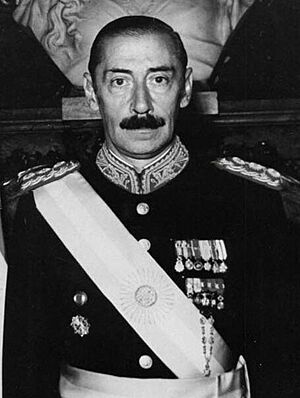
Official portrait, 1976
|
|
| 47th President of Argentina | |
| In office 29 March 1976 – 29 March 1981 |
|
| Vice President | Vacant |
| Preceded by | Isabel Perón |
| Succeeded by | Roberto Eduardo Viola |
| Governor of Tucumán | |
| In office 4 August – 10 December 1970 |
|
| Preceded by | Jorge Daniel Nanclares |
| Succeeded by | Carlos Alfredo Imbaud |
| Personal details | |
| Born | 2 August 1925 Mercedes, Buenos Aires, Argentina |
| Died | 17 May 2013 (aged 87) Marcos Paz, Buenos Aires, Argentina |
| Resting place | Memorial Cemetery, Pilar, Buenos Aires |
| Political party | None |
| Spouse |
Alicia Raquel Hartridge
(m. 1948) |
| Children | 7 |
| Education | Colegio Militar de la Nación |
| Profession | Military |
| Signature | |
| Military service | |
| Allegiance | |
| Branch/service | |
| Years of service | 1944–1981 |
| Rank | |
| Commands | Argentine Army (1976–1981) |
| Battles/wars |
Beagle conflict
|
| Criminal details | |
| Conviction(s) | Crimes against humanity; illegal repression during the last military dictatorship |
| Penalty | Life imprisonment |
| Trial | Trial of the Juntas |
| Imprisoned at | Marcos Paz Prison |
Jorge Rafael Videla (born August 2, 1925 – died May 17, 2013) was an Argentine military officer who became the 47th President of Argentina. He was also the first leader of the National Reorganization Process, a military government that ruled Argentina from 1976 to 1981. His time in power was known for many serious problems, especially regarding people's rights and the economy. This period happened during a time called Operation Condor in Latin America, which was part of the larger Cold War.
Videla came to power in a military takeover that removed President Isabel Perón from office. After Argentina returned to a democratic government in 1983, Videla was put on trial. In 1985, he was found guilty of serious crimes related to his time in power, including the disappearance of people and the illegal adoption of babies. He was sentenced to prison for these actions.
He remained under house arrest until 2008, when he was sent to a military prison. In 2010, Videla said he was responsible for his army's actions during his rule. Later that year, he was sentenced to life in a civilian prison for the deaths of 31 prisoners after the military takeover. In 2012, he received another 50-year sentence for the systematic kidnapping of children during his time as president. Videla died in prison in 2013 after a fall.
Contents
Early Life and Family
Jorge Rafael Videla was born on August 2, 1925, in the city of Mercedes, Argentina. He was the third of five sons born to Colonel Rafael Eugenio Videla Bengolea and María Olga Redondo Ojea. His two older twin brothers had died from measles in 1923, and Jorge was named in their honor.
On April 7, 1948, Videla married Alicia Raquel Hartridge. Her father was a professor and an ambassador. Jorge and Alicia had seven children together: María Cristina, Jorge Horacio, Alejandro Eugenio, María Isabel, Pedro Ignacio, Fernando Gabriel, and Rafael Patricio. Two of their sons, Rafael Patricio and Fernando Gabriel, later joined the Argentine Army.
Army Career
Videla began his military training at the National Military College (Colegio Militar de la Nación) in 1942. He graduated in 1944 as a second lieutenant. Over the years, he steadily moved up in rank within the infantry.
From 1958 to 1960, Videla worked at the Ministry of Defence. He then directed the Military Academy until 1962. In 1971, he was promoted to brigade general and became the Director of the National Military College. By late 1973, he was appointed Chief of Staff of the Army. In August 1975, President Isabel Perón made Videla the top leader of the Army, the General Commander of the Army.
Military Takeover in 1976
After President Juan Perón passed away, his wife and Vice President, Isabel Perón, became president. However, Argentina faced growing violence, social problems, and economic difficulties. Because of these issues, Videla led a military takeover that removed Isabel Perón from power on March 24, 1976.
After the takeover, a military group called a junta was formed. It included Videla, who represented the Army, Admiral Emilio Massera from the Navy, and Brigadier General Orlando Ramón Agosti from the Air Force.
Presidency
Two days after the military takeover, Jorge Rafael Videla officially became the President of Argentina.
Protecting Human Rights
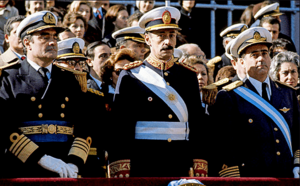
The military government led by Videla is remembered for serious problems regarding human rights. During this time, many people were taken by force and disappeared. These actions happened during a period when there were also violent groups operating in Argentina.
The military leaders said they took power to deal with these threats. However, human rights groups say that between 15,000 and 30,000 Argentines disappeared while they were held by the police or military. Some of these people were later released due to international pressure.
Videla himself later confirmed that thousands of Argentines were killed by his government between 1976 and 1983. Their bodies were hidden to prevent protests. Some Jewish Argentines also reported being targeted during this time.
Many Argentines have received money from the government as payment for the loss of their loved ones during this period. The military government took control of all legislative power, and military officers were placed in important government jobs.
Economic Changes
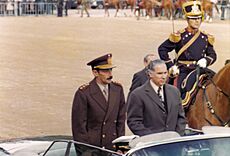
When Videla became president, Argentina's economy was in trouble with very high inflation. He gave control of economic policies to Minister José Alfredo Martínez de Hoz. This minister changed the economy to be more open to free trade and less regulated.
These changes aimed to help the economy grow. Inflation did go down a bit, but it was still high. During Videla's time, Argentina's foreign debt grew a lot, and the difference between rich and poor people became much bigger. This period ended with a large drop in the value of money and one of Argentina's worst financial crises.
International Relations
The military takeover in Argentina was known to the United States Department of State before it happened. Early on, the US government provided some security help to Videla's government. However, the new US President Jimmy Carter focused on human rights issues. In 1978, he convinced the US Congress to stop all arms sales to Argentina.
During Videla's rule, Argentina had a disagreement with Chile over some islands at the southern tip of South America, known as the Beagle conflict. Argentina even planned to invade the islands. However, Pope John Paul II helped to mediate the situation, which prevented a full-scale war. The conflict was finally settled after Videla left office, with a treaty that recognized Chile's ownership of the islands.
Even though Videla was against communism, his government kept good relations with the Soviet Union and China. Trade with these countries actually increased during his time as president.
Public Image
One of Videla's biggest challenges was how his government was seen by other countries. He believed that criticism about human rights was part of a campaign against Argentina.
On April 30, 1977, a group of women, including Azucena Villaflor, began protesting in front of the presidential palace in Buenos Aires. They were demanding to know what happened to their disappeared children. These women became known as the Mothers of the Plaza de Mayo (Madres de Plaza de Mayo).
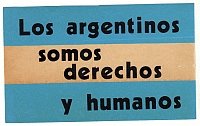
In 1979, the Inter-American Commission on Human Rights criticized Videla's government for many disappearances and abuses. In response, the government hired an advertising agency to create a slogan: Los argentinos somos derechos y humanos (meaning, "We Argentines are righteous and humane"). This slogan was put on bumper stickers to make it seem like people supported the government.
Videla also used the 1978 FIFA World Cup for political reasons. He pointed to the excitement of Argentine fans for their winning football team as proof that he and his government were popular.
In 1980, Adolfo Pérez Esquivel, a leader of the Peace and Justice Service, received the Nobel Peace Prize. He was recognized for telling the world about the human rights problems in Argentina.
Later Life
Videla handed over power to Roberto Eduardo Viola on March 29, 1981. The military government continued until it lost the Falklands war in 1982. Argentina returned to a democratic government in 1983.
The new government began to put top military officers on trial for crimes committed during the military rule. This was called the Trial of the Juntas in 1985. Videla was found guilty of many serious crimes, including killings and kidnappings. He was sentenced to life imprisonment and removed from the military in 1985.
Videla was in prison for five years. In 1990, President Carlos Menem pardoned Videla and other former military members. This pardon also included leftist guerrilla leaders. President Menem said he signed the pardons to help rebuild the country in peace.
Videla briefly returned to prison in 1998. A judge found him guilty of kidnapping babies during the Dirty War, including the child of a disappeared woman named Silvia Quintela. He was also found guilty of the disappearances of some guerrilla commanders. After 38 days, he was moved to house arrest due to health problems.
After Néstor Kirchner became president in 2003, there was a new effort in Argentina to show that Videla's rule was illegal. His portrait was removed from the military school. In 2005, Argentina's highest court ruled that the laws that had stopped prosecutions for crimes during the dictatorship were unconstitutional. This allowed the government to reopen investigations into human rights crimes.
In 2006, a judge ruled that the pardons given by President Menem were unconstitutional. In 2007, a federal court also canceled Videla's presidential pardon, bringing back his convictions for human rights abuses.
On July 2, 2010, Videla was put on trial again for new human rights violations. These charges were related to the deaths of 31 prisoners during his rule. Three days later, Videla said he was fully responsible for his army's actions. On December 22, 2010, the trial ended, and Videla was found guilty and sentenced to life in prison. He was immediately sent to a civilian prison. The judge said that Videla was "a manifestation of state terrorism."
On July 5, 2012, Videla was found guilty and sentenced to 50 years in prison. This was for his part in a plan to steal babies from parents who were held by the military government. The court said Videla helped in the "theft, retention, and hiding of minors, as well as replacing their identities." These children were given to military families for illegal adoption, and their true identities were hidden. It is thought that about 400 children were stolen during this time. By 2019, 130 of these adopted children had their true identities found.
Death
Jorge Rafael Videla died on May 17, 2013, while serving his sentence at a prison in Marcos Paz. Reports said he died of natural causes in his sleep. However, an autopsy showed he died from multiple broken bones and internal bleeding. These injuries were caused by a fall he had in a prison shower five days earlier, on May 12.
According to a 2009 rule, Videla and others found guilty of human rights violations were not allowed to have a military funeral. His family held a private ceremony instead. Videla remained a Roman Catholic throughout his life.
See also
 In Spanish: Jorge Rafael Videla para niños
In Spanish: Jorge Rafael Videla para niños
Images for kids
-
Bumper sticker commissioned by the junta in 1979. The text is a pun on derechos humanos, "human rights". "We Argentines are righteous and humans".


